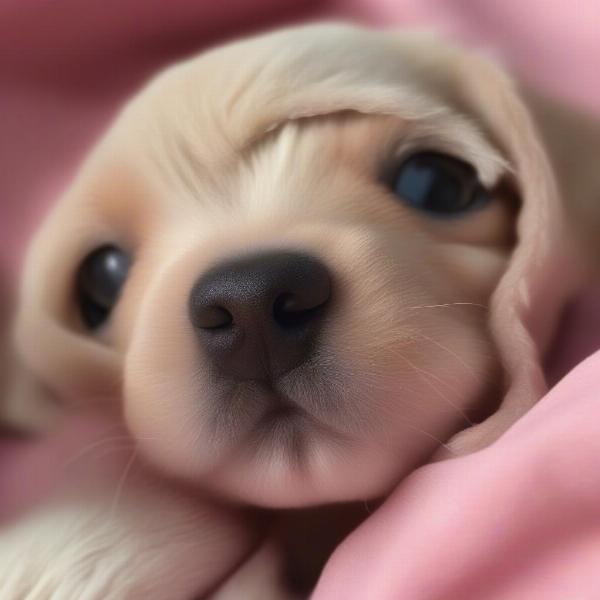Hooded vulvas in dogs, sometimes referred to as a “recessed vulva” or “juvenile vulva,” can be a source of concern for owners. While often a normal anatomical variation, particularly in puppies, it’s important to understand what a hooded vulva is, when it might be a problem, and how to ensure your dog’s health and hygiene. This article will provide you with a comprehensive guide to hooded vulvas in dogs, addressing common questions and concerns.
What is a Hooded Vulva?
A hooded vulva appears as a small, slit-like opening covered by a fold of skin. This “hood” can sometimes completely obscure the vulva, making it difficult to locate. This is particularly common in puppies and some breeds. As the dog matures, the vulva typically becomes more prominent. However, in some cases, the hooded vulva can persist into adulthood.
 Hooded Vulva in a Puppy
Hooded Vulva in a Puppy
Is a Hooded Vulva a Problem?
In many cases, a hooded vulva is simply a normal anatomical variation and doesn’t cause any health issues. However, it can sometimes predispose a dog to certain problems, particularly if the hood is very tight or the area isn’t kept clean.
Potential Issues Associated with Hooded Vulvas:
- Vaginitis: The skin fold can trap moisture and bacteria, leading to inflammation and infection of the vagina.
- Skin Irritation: Urine or fecal matter can become trapped under the hood, causing irritation and discomfort.
- Urinary Tract Infections (UTIs): Bacteria can more easily enter the urethra due to the proximity of the vulva to the skin fold, potentially leading to UTIs.
Breeds Prone to Hooded Vulvas
While any dog can have a hooded vulva, certain breeds are more predisposed to it. These include breeds with loose skin or wrinkles, such as:
- English Bulldogs
- French Bulldogs
- Pugs
- Shar-Peis
Caring for a Dog with a Hooded Vulva
Proper hygiene is essential for dogs with hooded vulvas to prevent infections and irritation.
Cleaning a Hooded Vulva:
- Use a warm, damp cloth to gently clean the area around the vulva after urination or defecation.
- Ensure the area is thoroughly dried to prevent moisture buildup.
- Avoid using harsh soaps or chemicals, which can irritate the sensitive skin.
- Consult your veterinarian if you notice any signs of infection or irritation.
When to See a Veterinarian
While a hooded vulva is often benign, it’s crucial to seek veterinary attention if you notice any of the following:
- Persistent redness or swelling around the vulva
- Foul-smelling discharge
- Excessive licking or chewing of the area
- Difficulty urinating
- Lethargy or loss of appetite
Conclusion
Understanding and properly caring for a dog with a hooded vulva is an important part of responsible pet ownership. While often a normal anatomical variation, it’s important to be aware of the potential complications and maintain proper hygiene to prevent infections and ensure your dog’s comfort and well-being. Regular checks and prompt veterinary attention when needed will help keep your furry friend happy and healthy.
FAQ
- What is a recessed vulva in a dog? A recessed or hooded vulva is a vulva that is covered by a fold of skin.
- Is a hooded vulva always a problem? No, it is often a normal variation, particularly in puppies.
- What breeds are prone to hooded vulvas? Breeds with loose skin, such as Bulldogs and Shar-Peis.
- How do I clean a hooded vulva? Gently clean the area with a warm, damp cloth and ensure it’s dry.
- When should I see a vet about a hooded vulva? If you notice redness, swelling, discharge, or any signs of discomfort.
Connect with ILM Dog
ILM Dog is your trusted resource for expert dog care advice. We offer a wealth of information on dog breeds, health, training, nutrition, grooming, and much more. We help dog owners worldwide provide the best possible care for their canine companions. From choosing the right breed to understanding complex health concerns, ILM Dog has you covered. Contact us today for expert guidance on all aspects of dog care: Email: [email protected], Phone: +44 20-3965-8624.